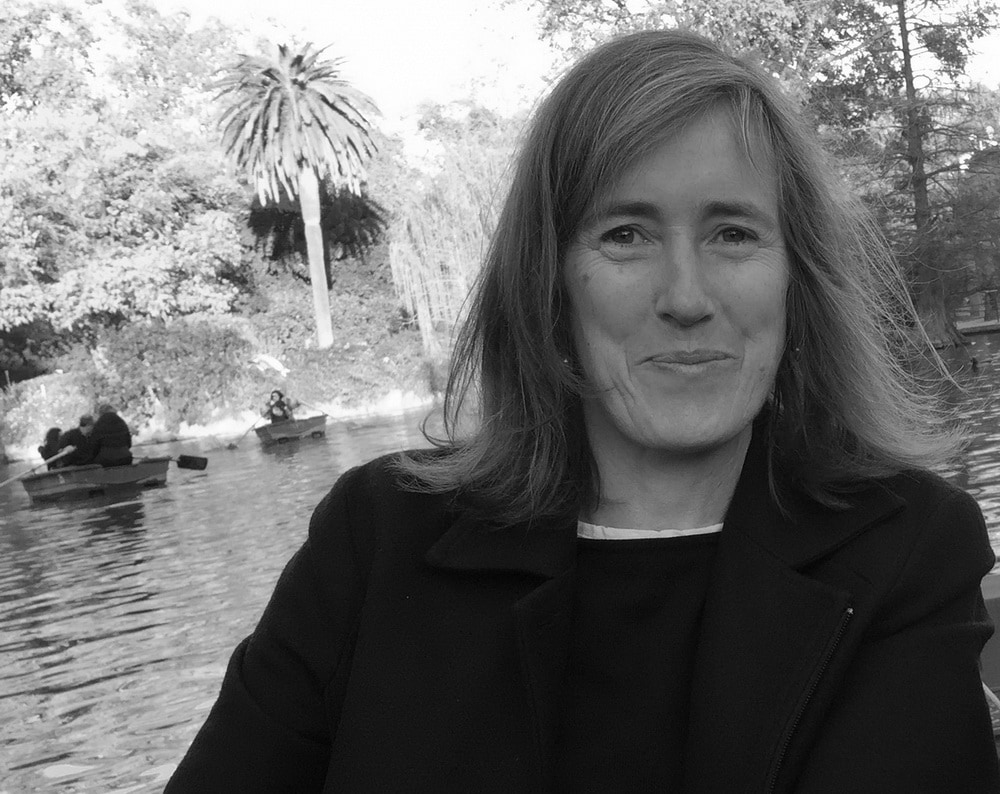
Leading us down the road to the heart of the country, where the artists live, CrossPASS is an exhibition of both collaborative and individual jewels by Demitra Thomloudis and Motoko Furuhashi. With cartographer’s eyes, they materialize in jewelry form the navigated landscapes they have explored, seeking to enable wearers and viewers to accompany them to these sites, revealing something of the journey itself and stories each site imparts. The result of their unusual multimedia research is currently on show at Velvet da Vinci.
Vicki Mason: Tell us how you met and how you came to be exhibiting and collaborating together.
Motoko and Demi: In the 2014/2015 academic year, we were both teaching at separate universities (Motoko at New Mexico State University, Demi at The University of Texas at El Paso) in the area where the project is based. As colleagues in this very isolated location, we would travel the 46 miles between Las Cruces, New Mexico, and El Paso, Texas, to visit each other often and bring together our students, all in an attempt to build a community between both university programs and the jewelry/metals community within the cities themselves.
Having this professional relationship and a common fascination with the surrounding landscape, we decided to merge our research efforts connected to site-specificity. Guided by the framework of the Interstate 10 corridor, which connects each of our “home” cities, we began this collaborative project where we could both express our shared and individual perspectives in relationship to place.
Your exhibition title, CrossPASS, can be read many ways. It can evoke ideas of location, specific points on a map, and progress along a road, either literally or as a metaphor of the self. What was the genesis for the title and overarching themes the title and works seek to illuminate?
Motoko and Demi: It seemed fitting to break down the meaning behind both cities—Las Cruces, which is known as the “City of the Crosses,” and El Paso, which directly translates from Spanish to “The Pass,” in order to title the project. We feel these words together embody the spirit of the project. The objective of CrossPASS is to allow specific locations and our shared personal inquiries along this route to initiate the collection of images, video, and sound which directly influenced the creation of jewelry and objects. We wanted the title of the project to directly reflect our physical journey to and through specific sites. The road, the unique borderplex region, the physical connection of one city to the other, and our “crossing” of disciplines are all things we considered when arriving at the title.
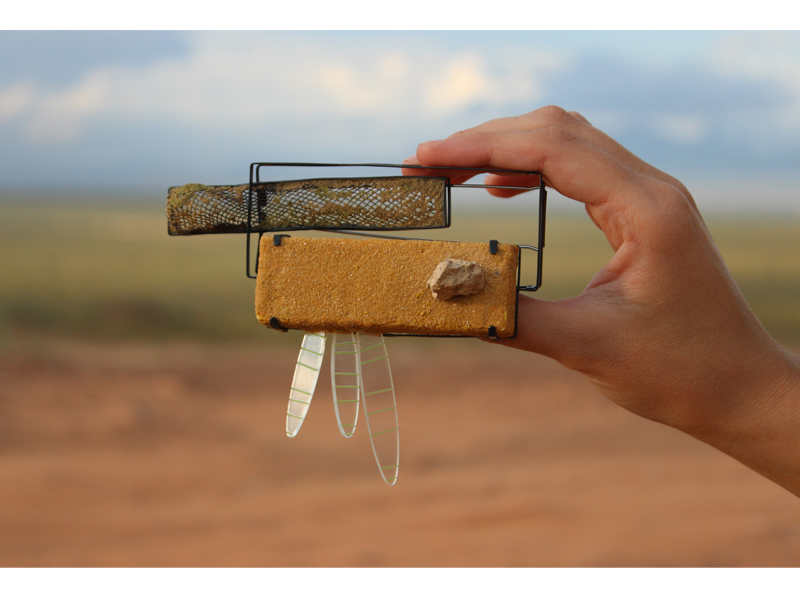
What was it about the stretch of road you chose to investigate with this series of works that grabbed you?
Motoko and Demi: We have both lived many different places within the United States, but there was something truly unique and special about these two cities, the dramatic desert terrain which lies between them, and the rich cultural/regional identities they each share across their borders. We were completely drawn to what this route could offer our creative process, and to the desert which lies between them. For others, these cities and this stretch of highway are just something to pass through in order to get somewhere else. From the dairy farm located near Mesquite, New Mexico (site # 3), to the city of Anthony (site # 5), where Texas and New Mexico share a city and border, our project reduces the speed from 75 mph to 0 mph, intimately examining places which would otherwise be insignificant to others. The data collection from these sites has inspired the jewelry and objects in the project in hopes that our intimate experiences are embodied within them. The interactive website we created allows the viewer to explore these sites further, gaining a deeper perspective in relation to each site.
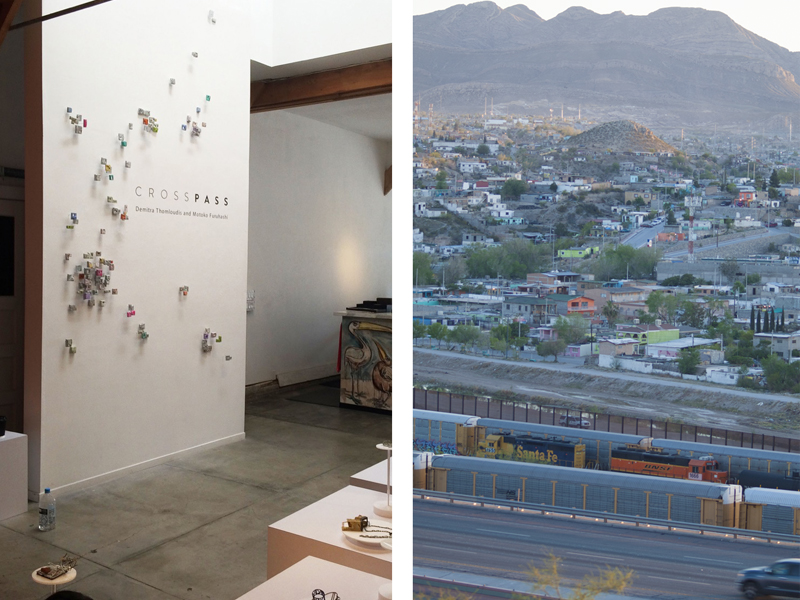
Did you make any works on site, or collect materials from your sites for inclusion in the works?
Demi: The collaborative works along Interstate 10 have actual components that were collected directly from the site and/or are inspired by the site itself. For my solo work—consisting of over 90 small brooches made from concrete—I was inspired by the view across the US/Mexico border into a neighborhood of Juarez called Anapra. Anapra is one of the poorest communities within the city, and as I parked my car for work every day at the university, I would have an unobstructed view. The homes across the border in this neighborhood are squat, in a state of constant flux, and seem to crowd and layer the mountainside. As you look at Anapra from a distance, the singular homes painted in bright colors stand out like gems and decorate the dry desert landscape.
Motoko: My solo contributions to the project consist of my tape brooches and tape sculptures, which are created by a direct intake of the site. These objects are made by rolling the tape on the road and winding them back up. The tape physically captures whatever is lying on the ground in that moment and collects it within the finished wound object. My process is very methodical, I lay the tape down inch by inch for short and long distances. In order to take the viewer further into my process, I have recorded video as the pieces are created. These are located on our interactive website.

How did you negotiate the making of the collaborative works? Were you together at the time works were made, or was work sent back and forth between you?
Motoko and Demi: Both. When the project began, we were both living in the area and could work together very easily. When Demi had to relocate for a tenure appointment at Kent State University, we would send the pieces back and forth and set up rules to follow for the collaboration process. During that time apart, we also found time to travel and work with each other in real time. During breaks, Demi would come to Las Cruces to work, collect data, and make multiple trips up and down the interstate. In other cases, we took advantage of working together during our Smitten Forum Residency at Pocosin Arts and our time at Penland School of Crafts. Oh, and Skype—lots of Skype!
Tell us about the exhibition design and installation. Will the photography, video, and sound be shown with the jewelry in the exhibition? If so, what do you think this brings to the reading of the works when seen in the gallery setting, as compared to how they will be read once they move out into the wider world?
Motoko and Demi: Throughout the exhibition the viewer is asked to accompany us on our investigation. The collaborative works are displayed in consecutive order according to the site map we created. We intentionally set the work low to the ground, sitting at about 2 feet (61 cm) in height so that the viewer physically has to crouch down to investigate the works and encounter the pieces in a way which feels more like a discovery rather than a display. Beside each of the works is a QR code which can be scanned by a smart phone and which will directly load the Google map coordinates of the site, photographs of the jewelry on site and on the body, and on-site video, sound, or digital photography, thus adding another layer of depth to understanding the essence of the site.

Imperfection, the decaying and idiomatic built environment, the road, and the vast American landscape are just some of the themes evident in works like Site #2 and Site #5. Similarly, the exhibition’s promotional image shows a hand buried in sand, evoking death—and in the context of this election campaign, fatalities on the Mexican-American border. Can you tell us about the intended political aspect of your work?
Motoko and Demi: Our work is not intended to be political. The objective of CrossPASS is to allow site-specific locations and our shared personal inquiries along this route to initiate the collection of images, video, and sound that directly influences the creation of jewelry and objects. We are truly interested in how site-specificity can guide the conceptual and physical manifestation of our work and how the project uniquely discovers/rediscovers these sites through the body.
The promotional image is a still image from the video component connected to site #4. On that day, our research led us to a sand-covered hilltop about 13 miles from the highway. In the blistering heat and intense rays of the desert sun, we climbed this hill, had our bare feet and hands physically connected to the site as we collected sand from the location and documented our physical interaction with the location. It is the physical connection with the site and our bodies which initiated the creation of Site # 4 brooch. We saw this process as critical and unique to our project.
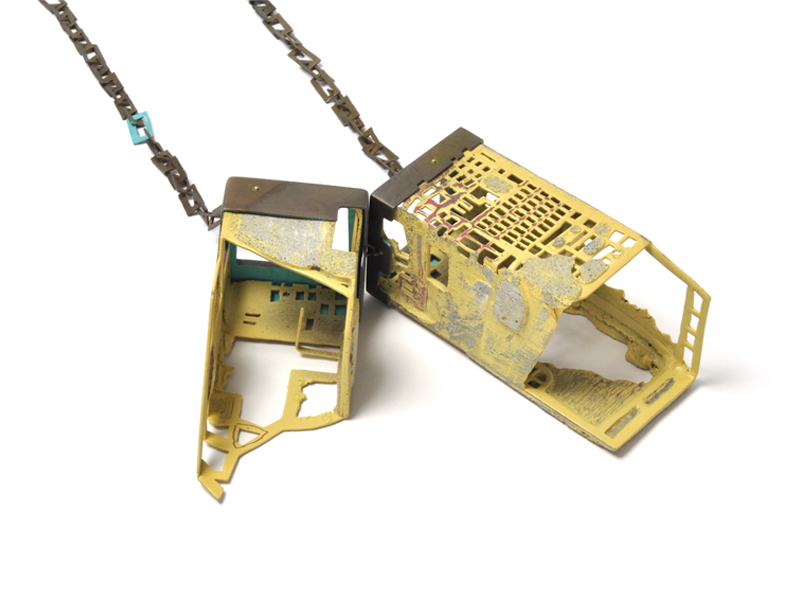
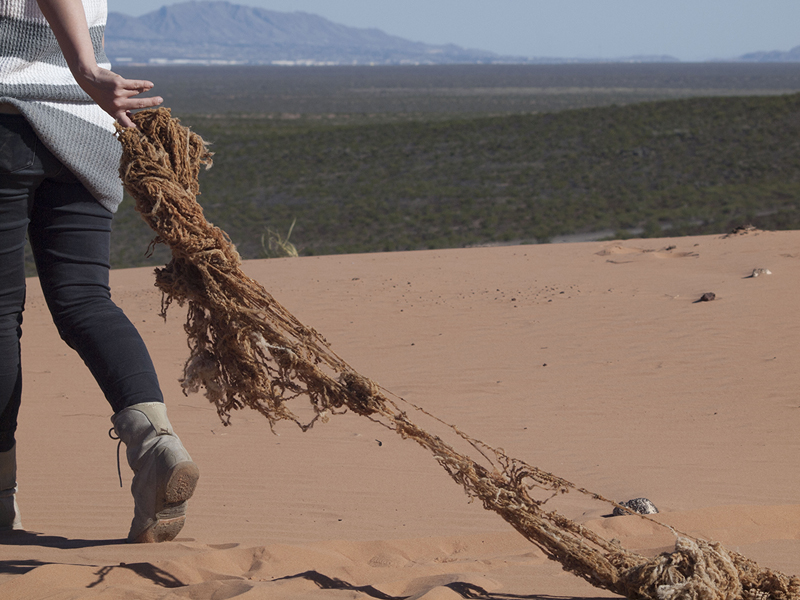
One of the questions that comes to mind when looking at jewelry that deals with loaded sites—and I am thinking here about La Frontera, an exhibition curated by VdV, but also of Jacqui Chan’s Host a Brooch project—is whether jewelry is an easy medium to address these concerns. What do you think is jewelry’s unique contribution to engaged art?
Motoko and Demi: Our intention for the project was to allow our research to exist beyond the walls of the gallery and connect with the viewer/wearer intimately. Jewelry is a perfect vehicle to access an audience on both of these fronts, and allows the work to travel beyond the site’s influence and connect with others. Our interactive website addresses these issues and allows the work and the research to reach a much larger audience.
What have you found enlightening and inhibiting about the collaborative process?
Motoko and Demi: In working on this project we have both found that open communication, being responsive to one another, respecting our shared and individual visions, and tapping into our personal strengths are essential elements to the collaborative process.
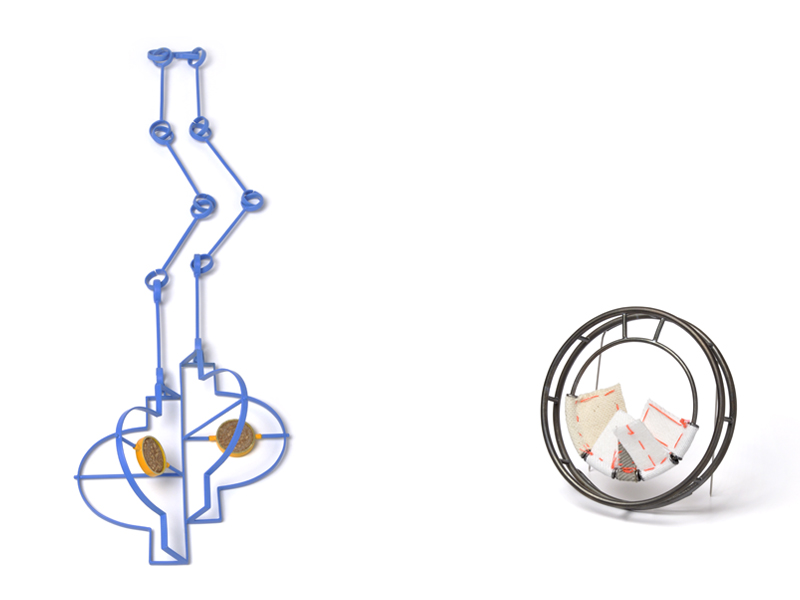
Will you collaborate again?
Motoko and Demi: YES! While this exhibition is up at Velvet da Vinci, we will be working on a catalog for the project, which will include essays, photography, and more details related to the project.
Can you tell us what you were reading when this body of work came into being?
Motoko: I have always admired Miwon Kwon’s book, One Place after Another: Site-Specific Art and Locational Identity. Specifically for the project, I did field research trips to local museums: New Mexico Farm & Ranch Heritage Museum; El Paso Museum of History; El Paso Museum of Archaeology; community organizations; state border visitors center. And I interviewed local people to share their experiences in relation to the specific site locations.
Demi: The Roads that Built America: The Incredible Story of the U.S. Interstate System, by Dan McNichol; El Paso 120: Edge of the Southwest, by Mark Paulda; and Drug War Zone: Frontline Dispatches from the Streets of El Paso and Juarez, by Howard Campbell.

You both trained in the US. What sort of conversations have you had with each other regarding your own tertiary education, and what do you both in turn as educators hope to impart to your students?
Motoko: Similarly, we both tap our feet to other cultures, Demi’s in Greece and I in Japan. We all know that the world is getting smaller and smaller thanks to technology, yet there is a great amount of resources and information out there. I hope that we can share our work with our students so they may be inspired to seek out their own experiences.
Our community is very special, and unique compared with other mediums. We are very close to each other, support each other, and I feel as though I am part of a family. I have such amazing mentors and educators in my life, and I really hope that I can do the same for the next generations!
Demi: I believe the most important aspect of an educator rooted in higher education is to be an active participant in their field. From my own research and experiences I can then bring that same energy back into the classroom, which is so incredibly valuable to my students.
What location would you like the road to take you both to next?
Motoko and Demi: Anywhere and everywhere! Definitely overseas.
Thank you.
The works in this exhibition range in price between US$225 and $900.
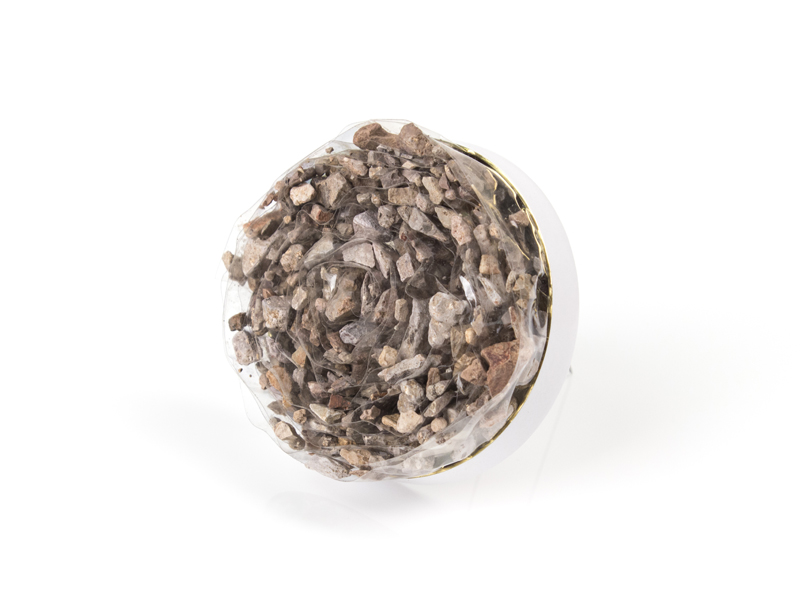
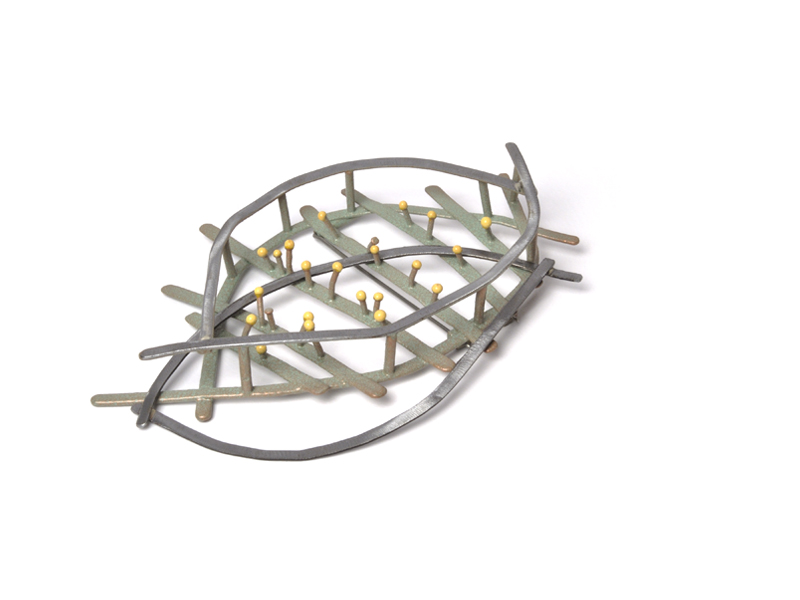
INDEX IMAGE: Motoko Furuhashi and Demitra Thomloudis, Site #2, 2016, brooch, nickel silver, brass, silver, land segment, ink jet print, gesso, 100 x 110 x 45 mm, photo: Sara Brown
